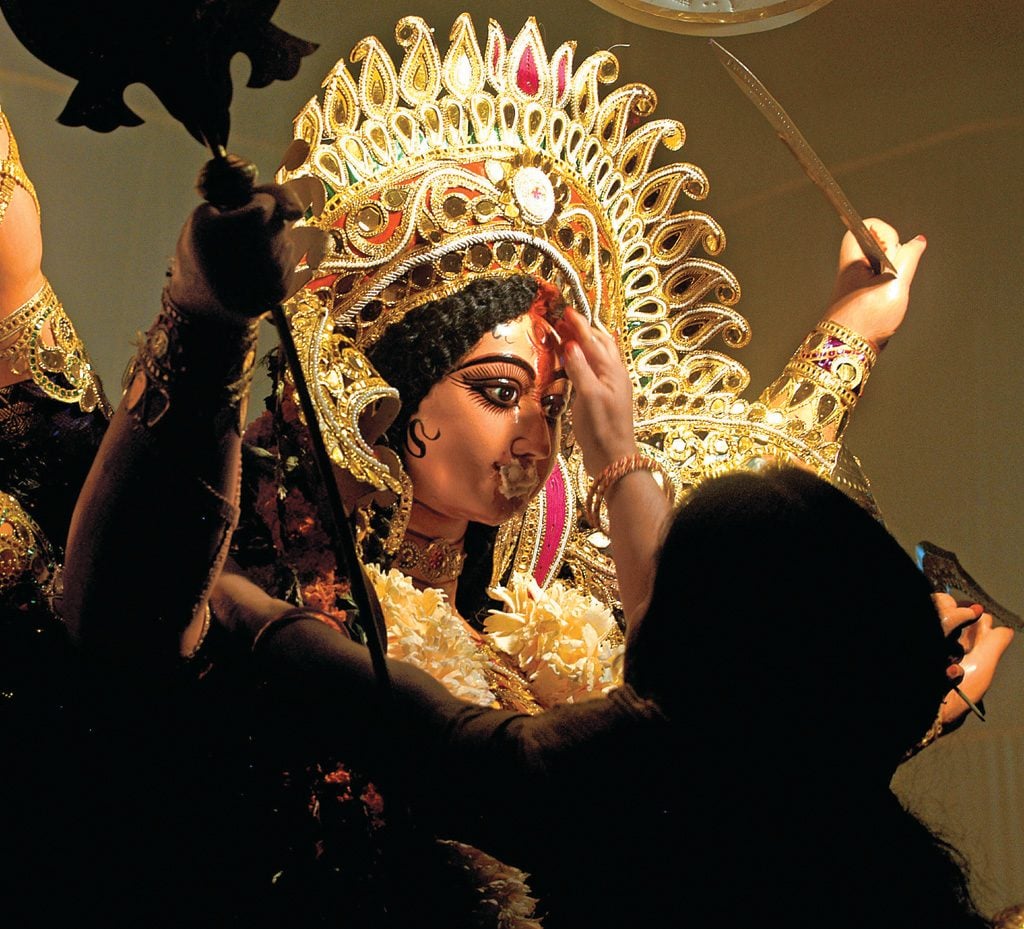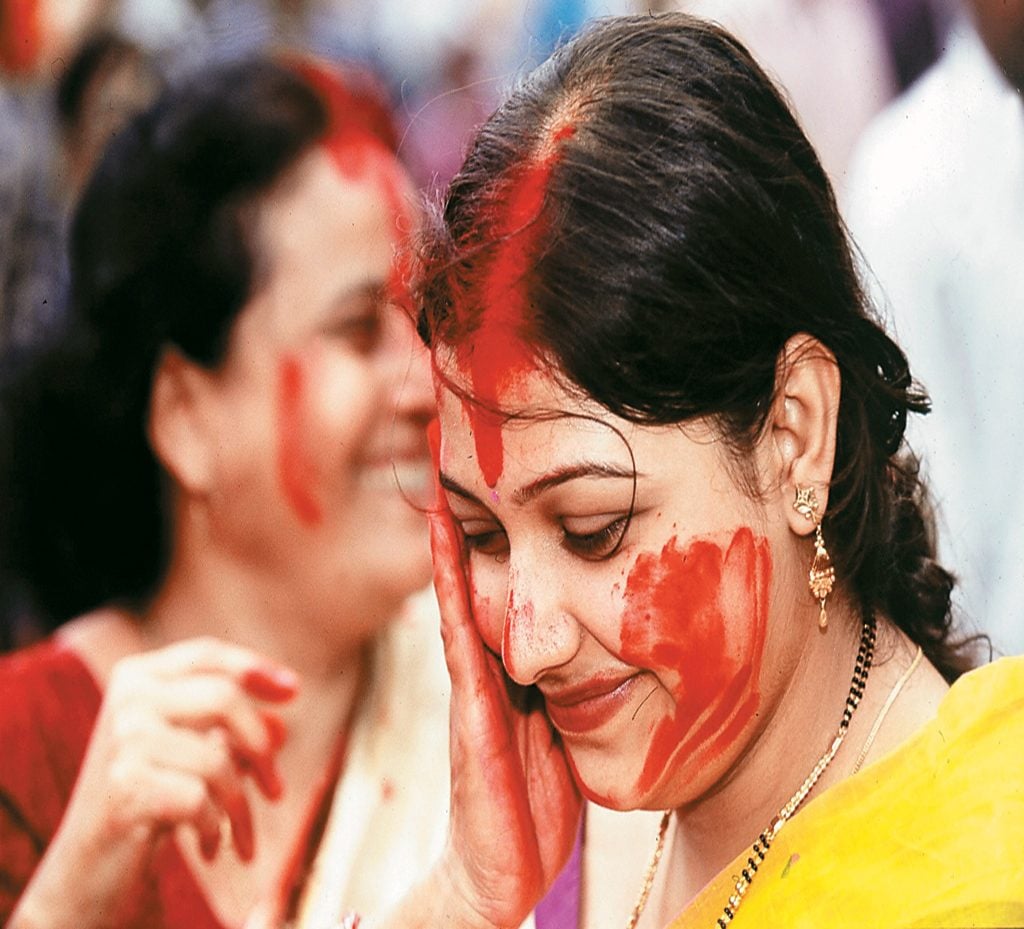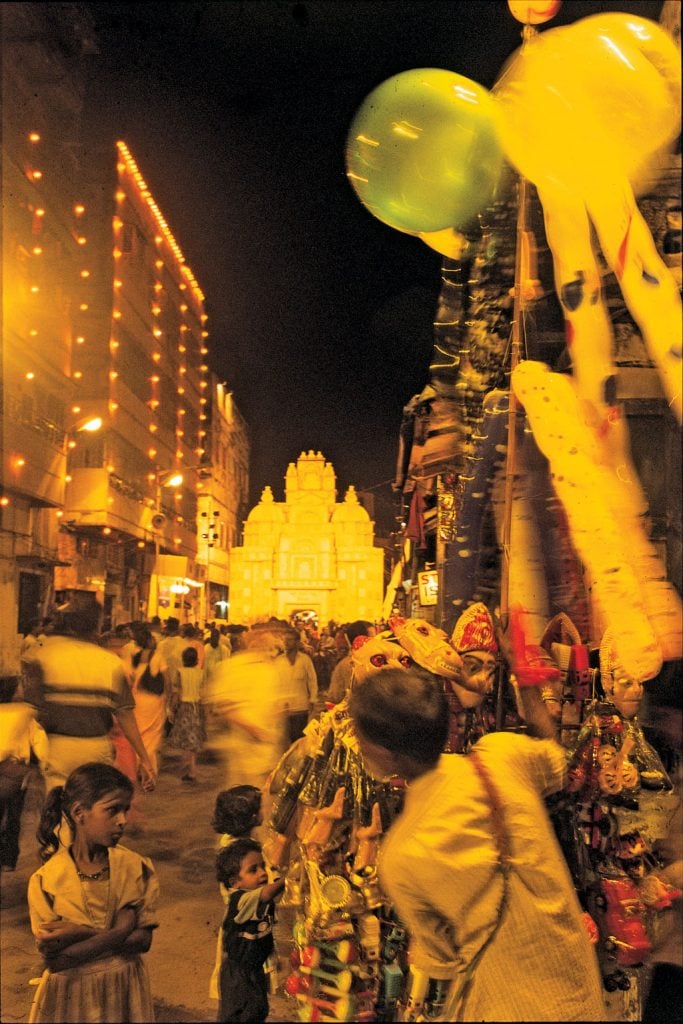Type Religious Festival Time 5 Days in October Location Kolkata
Durga Puja is the biggest festival of West Bengal and Bengalis fondly call it pujo. Ostensibly a Hindu religious festival, it has risen in grandeur and people of all backgrounds, irrespective of their religious views, have started participating in it.
In Kolkata, the excitement begins much before autumn even arrives. Shops start announcing puja sales and there is frenzied buying of gifts everywhere. It is a tradition in most Bengali homes to wear a brand new outfit each day of the puja and exchange new clothes much before the actual puja week. This is done so that there is enough time to buy matching accessories or make alterations, if required.
At the busy Gariahat Market in south Kolkata, Dolon Dhar has just bought seven saris from a handloom store. And it’s only the first week of September. “I should have started much earlier,” she laments. “It’s unlikely that any tailor is going to accept any more orders.” A visit to the tailoring shops lining Kolkata’s Park Circus area corroborates her fears. “I have so many orders for blouses. I don’t know how I’m going to deliver them by the puja week,” cribs master tailor Hyder Ali.
The puja week also becomes some sort of a unit for measuring time, and the phrase “before pujo” or “after pujo” becomes so ubiquitous, you can hear it being uttered everywhere by fellow passengers aboard public conveyances, in market places, at restaurants, and in offices.
History
According to Krittibas Ramayana, Goddess Durga was worshipped in spring, but Lord Ram had to invoke her in the autumn for contingencies of battle so he could defeat Ravana. There are records of Durga Puja being held in Bengal in the medieval period and in the courts of Rajshahi in the 16th century and in Nadia District in the 18th century.
The festival is held from the sixth to tenth day of the waning moon in Ashvin, which is the sixth month in the Bengali calendar. The corresponding month in the Gregorian calendar is October. The festivities coincide with the Navratri and Dussehra celebrations that take place across the rest of the country.
Durga is the embodiment of divine cosmic energy and there are several stories about how she came into being. According to Shiva Purana, Lord Shiva invoked her from the left half of his body; while the Devi Mahatmyam says she manifested from the energies put together by all the gods, so as to kill Mahishasura.
preparation for the festival
A few weeks before the countdown begins, you suddenly start noticing changes in the city’s landscape. Artisans come in droves from surroundings villages, towns and suburban Kolkata to construct, design and decorate the pandals – the temporary temples – that will house the deities.
The pandals crop up all over the city, tens of thousands of them. Anywhere where there is an iota of space really. Parks and pavements, playgrounds and parking lots – nothing is spared. Major roads are cordoned off and sometimes when you are driving down your usual route to work or returning home, you may suddenly have to stop, turn back and take a detour.
The skeletal structures of pandals are made from bamboo. The frames are then covered with cloth or canvas. The pandals are usually elaborate works of art with themes borrowed from history and religion. Many of them are modelled after famous temples or monuments such as the Taj Mahal and are often as imposing as the India Gate. The structures often look so real that it is impossible for an outsider to know that it’s not a permanent structure.
Of Gods and Demons
Ma Durga (Mother Durga), as the Bengalis call her, arrives on a lion (her mascot), her 10 arms wielding weapons of war. At her feet lies the villain, the demon Mahishasura, the symbol of evil, slain, blood spurting out of his chest, which has just been pierced by her spear.
Durga is flanked on either side by her four children. Her two daughters Lakshmi and Saraswati, goddesses in their own right – the former of wealth and the latter of knowledge – are escorted by their own faithful mascots, the owl and the swan respectively. Also accompanying Durga are her two sons, the pious Ganesha and the foppish Kartikeya, piggybacked on their mascots, the rat and the peacock respectively.
- An idol of Durga
- The joyful sindoor khela
- A busy street during pujo time in Kolkata
The clay idols, dressed up in colourful cloth and glittering gems, brandishing an assortment of articles such as weapons of war and musical instruments, are not less than six feet in height. They look formidable when mounted on raised platforms inside the pandals. The visages of the deities vary according to the imagination of the sculptors, who customise the idols as per the specifications of the puja organisers. There have been instances when Durga’s face was made to resemble popular movie heroines or even female political figures. The demon’s head too has many a times been made to resemble unpopular public figures.
Arrival and Departure
Imagine hundreds of such entourages rolling into the city of Kolkata from suburban workstations, especially from the famous artisans’ village of Kumartuli. There is no denying that one of the biggest crowd pullers of Durga Puja is the visarjan (immersion procession), when on Bijoy Dashami (the last day of the pujas), the idols are taken, usually in open trucks and vans, accompanied by huge crowds to a nearby waterbody, preferably the sacred Ganga, to be immersed. This symbolises Durga’s return to her husband’s home. Crowds throng the streets to witness this, lining the procession routes, peering out of windows and hanging out of balconies or rooftops to catch a glimpse. If you are in the middle of one such crowd, you’ll be aware of people around you crying, even howling, as they bid an emotional farewell to their beloved goddess.
The Five Days
Once the deities arrive, the city of Kolkata never sleeps. And if it does, it wakes up to a constant sound of drumbeats and blowing of conch shells. And there’s the cacophony of a fusion of sounds emanating from loudspeakers – playing anything from Indipop to the Bengali Rabindra Sangeet – which almost every pandal is fitted with.
The city also wakes up to a variety of aromas. The fragrance of burning incense, of floral offerings, and of hot food emanating from thousands of temporary stalls that mushroom throughout the city, selling everything from paranthas to pancakes. Amidst this fusion of sounds and aromas, devotees dressed in vibrantly-coloured attire arrive in droves from the suburbs of Kolkata and dance on the streets. They hop from pandal to pandal, standing in serpentine queues for a darshan of the devi.

Prayers and rituals begin from day 1, which is Shashthi. During the evenings, women perform a dance known as dhunuchi naach, which involves dancing with earthen pots filled with burning incense. On Bijoy Dashami, married women play with sindoor, smearing it on each other and applying it to the goddess. This ritual is called sindoor khela and is held just before the visarjan.
For five evenings, the city lights up like a galaxy. Lighting work by artisans brought in to decorate the pandals – both the interiors and exteriors – is supposed to be one of the best in the world. Nathan Michael, an art scholar from Chicago, who had seen the puja for the first time in 2006, said, “it is sure to surpass all expectations”.

SHOPPING
Though people are ideally supposed to have finished shopping before Durga Puja, you will notice that there is still a mad rush of frenzied last-minute buyers of gifts at shopping malls and markets. Check out the stores at the famous Gariahat, close to Kalighat Metro Station. Handloom saris and handcrafted silver jewellery are available here. Other shopping havens are New Market near Esplanade Metro Station and Dakshinapan in south Kolkata.
WHERE TO STAY
Among the top end hotels in Kolkata, The Oberoi Grand (Tel: 033-22492323; Tariff: On request), on JL Nehru Road, wins with its location, though many prefer the Taj Bengal (Tel: 66123939; Tariff: On request) on Belvedere Road. Other options in this exclusive class are The Park (Tel: 40049000; Tariff: ₹14,000–20,000) and ITC Sonar (Tel: 23454545; Tariff: ₹16,500–1,25,000).
Hotel Hindustan International (Tel: 22802323, 40018000/ 80; Tariff: ₹13,000–22,000) and Peerless Inn (Tel: 33016124; Tariff: ₹14,000–20,000) are evergreen favourites of tourists. Two less expensive options, The Astor (Tel: 22829950/ 57-59; Tariff: ₹5,000–13,500) and the Golden Parkk (Tel: 22883939; Tariff: ₹9,000–11,000) are located in the heart of town.
Some pocket-friendly options are the Fairlawn Hotel (Tel: 22521510/ 8767/ 0125; Tariff: ₹3,500–4,000), and Hotel Royal Garden (Tel: 33132147, Cell: 09836940037; Tariff: ₹3,000–4,500) on Park Street.
WHERE TO EAT
For an authentic Bengali meal at reasonable prices, nothing beats the Bhojohori Manna chain of restaurants, which has many branches in Kolkata. Try mutton dakbanglow – a spicy curry with succulent pieces of meat – with plain rice. Follow it up with mango papad chutney. For dessert, try their rasmalai or rabri. Aheli at the Peerless Inn gives traditional ghee bhat (hot rice with home-made butter) and luchi cholar dal (puri with chickpea dal). The lamb biryani at Dum Pukht at ITC Sonar is superb. You should also try the delicious beef biryani at Nefil in Park Circus.
Nizam’s, behind New Market, is where the kathi roll was invented. Shiraz on Park Street-Mullick Bazaar Crossing is an Irani joint.
Fast Facts
Tourist Office
WBTDC
3/2, BBD Bagh (East)
Kolkata
Tel: 033-22436440, 22488271
Cell: 09836621200, 09051496258, 08334870300
W wbtourism.gov.in
STD code 033
GETTING THERE
Air Kolkata’s Netaji Subhas Chandra Bose International Airport (14km) is well connected by many domestic and international flights. Taxi costs ₹200–400
Rail Kolkata’s Howrah and Sealdah stations are connected by Rajdhani and many express trains to the rest of India. Radio cab services are also available
Road NH2 – the iconic Grand Trunk Road – links Kolkata to Delhi via Varanasi and Agra. For getting around in the city, opt for a rented car with predetermined rates for a number of hours or kilometres. Taxis are available everywhere in the city. Rented cars are a good bet for those planning pandal-hopping. Transport is hard to come by in the late hours
Tip Many roads are cordoned off during pujo time because of the pandals and the crowds, and parking is a problem. Autos are a cheaper option, so is the metro, which connects the north of the city to the south (30mins). Join the pandal-hopping crowds on foot if you aren’t venturing too far







